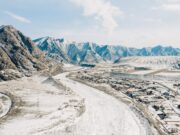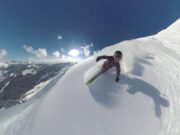Popular Winter Sports in the Alps
Skiing: Top Resorts for Every Skier
The Alps are renowned for their world-class skiing, offering slopes suitable for every level of skier. Famous resorts like St. Moritz in Switzerland, Courchevel in France, and Zermatt in Switzerland provide exceptional skiing experiences. St. Moritz is known for its luxury and excellent cross-country trails, while Courchevel offers a vast network of interconnected runs. Zermatt, located at the foot of the iconic Matterhorn, provides a unique skiing experience with year-round options at high altitudes.
Snowboarding: Destinations for All Skill Levels
Snowboarding in the Alps is equally popular, with many resorts catering to snowboarders of varying skill levels. In addition to St. Moritz and Zermatt, resorts like Verbier and Chamonix are well-loved for their diverse terrain, including freestyle parks and off-piste areas. These destinations offer something for everyone, from beginners learning to carve to experts seeking thrilling powder runs.
Ice Skating: A Classic Alpine Experience
Ice skating is a timeless Alpine activity, with picturesque rinks set against stunning snowy backdrops. Popular rinks include the frozen lakes in St. Moritz and smaller, charming rinks in towns like Gstaad and Zermatt. Skating on a frozen Alpine lake offers an unparalleled experience, allowing visitors to glide through serene natural landscapes.
Thrilling Adventure Activities
Ice Climbing on Frozen Waterfalls and Icy Cliffs
Ice climbing is one of the most exhilarating winter sports in the Alps, offering an opportunity to scale frozen waterfalls and sheer icy cliffs. Adventurers use specialized gear, including axes and crampons, to ascend vertical ice formations. Popular ice climbing destinations include the Saas Fee region in Switzerland and the French Alps, where climbers can tackle frozen waterfalls that form during the winter months. The challenge and beauty of scaling ice make it an unforgettable experience for thrill-seekers.
Paragliding Over Snowy Alpine Landscapes
For those seeking a bird’s-eye view of the Alps, paragliding offers an exciting and unique perspective. Gliding above the snow-covered peaks and valleys provides a peaceful yet thrilling adventure. Paragliding is available in top Alpine destinations such as Interlaken in Switzerland and Chamonix in France, where experienced pilots can soar over the stunning wintry landscapes. Whether you’re a beginner or an experienced flyer, the Alps offer breathtaking views and the thrill of flight.
Dog Sledding and Snowmobile Rides
For an adventurous and authentic winter experience, dog sledding and snowmobile rides are popular options in the Alps. Dog sledding allows visitors to travel through remote snow-covered terrain, led by a team of huskies. Snowmobile tours provide a high-speed way to explore the Alpine wilderness, taking riders through forests, across frozen lakes, and up mountain trails, offering an adrenaline rush and the chance to discover the Alps in a truly unique way.
Family-Friendly Winter Activities
Tobogganing and Sledding for All Ages
Tobogganing and sledding are perfect winter activities for families of all ages. The Alps offer numerous dedicated sledging runs, providing safe and fun experiences for children and adults alike. Resorts like Davos and Gstaad feature long, well-maintained sledding tracks where families can enjoy the thrill of racing down the slopes together. These activities are ideal for those looking for a lighter winter adventure while still enjoying the Alpine scenery.
Winter Hiking and Snowshoeing Through Serene Alpine Trails
Winter hiking and snowshoeing are wonderful ways to explore the quiet beauty of the Alps. Families can enjoy the crisp mountain air while walking along snow-covered trails, such as those found in the Swiss and Austrian Alps. Snowshoeing offers a unique experience, allowing families to trek through deep snow while taking in stunning landscapes. These activities are accessible to beginners and offer a peaceful way to appreciate the Alpine environment away from the crowds.
Visiting Winter Festivals and Christmas Markets in Alpine Towns
The Alps come alive with charm during the winter months, especially in Alpine towns hosting traditional festivals and Christmas markets. These markets, such as those in Salzburg, Innsbruck, and Montreux, feature handcrafted goods, festive treats, and warm drinks. Families can immerse themselves in the holiday spirit, enjoying local customs, live music, and festive lights while exploring these enchanting winter wonderlands.
Preparing for Your Alpine Adventure
Best Times to Visit for Winter Sports and Activities
The best time to visit the Alps for winter sports is typically between December and April, when the region is blanketed in snow, and ski resorts are fully operational. December to February offers peak winter conditions, with the snow base at its deepest. However, March and April are also excellent months, offering milder temperatures and longer daylight hours while still providing good snow coverage, making it ideal for skiing, snowboarding, and other outdoor activities.
Essential Gear and Clothing for Cold-Weather Adventures
To ensure a comfortable and safe experience in the Alps, proper gear is crucial. Layering is key for managing the cold, with moisture-wicking base layers, insulating mid-layers, and a waterproof outer layer. Make sure to wear thermal socks, gloves, and a hat to protect extremities from the cold. Skiers and snowboarders should also have appropriate outerwear like jackets and pants designed for snow. Other essential items include goggles, sunscreen, and durable footwear for outdoor activities.
Safety Tips and Guidelines for Enjoying Winter Sports in High Altitudes
When engaging in winter sports in the Alps, safety is paramount. Always check weather forecasts before heading out, as conditions can change rapidly in mountainous terrain. For skiing or snowboarding, ensure that you have the necessary training or hire a guide if unfamiliar with the area. It’s also important to stay hydrated, take regular breaks, and wear a helmet for protection. Be mindful of avalanche risks and follow local safety guidelines when exploring off-piste areas.

















































